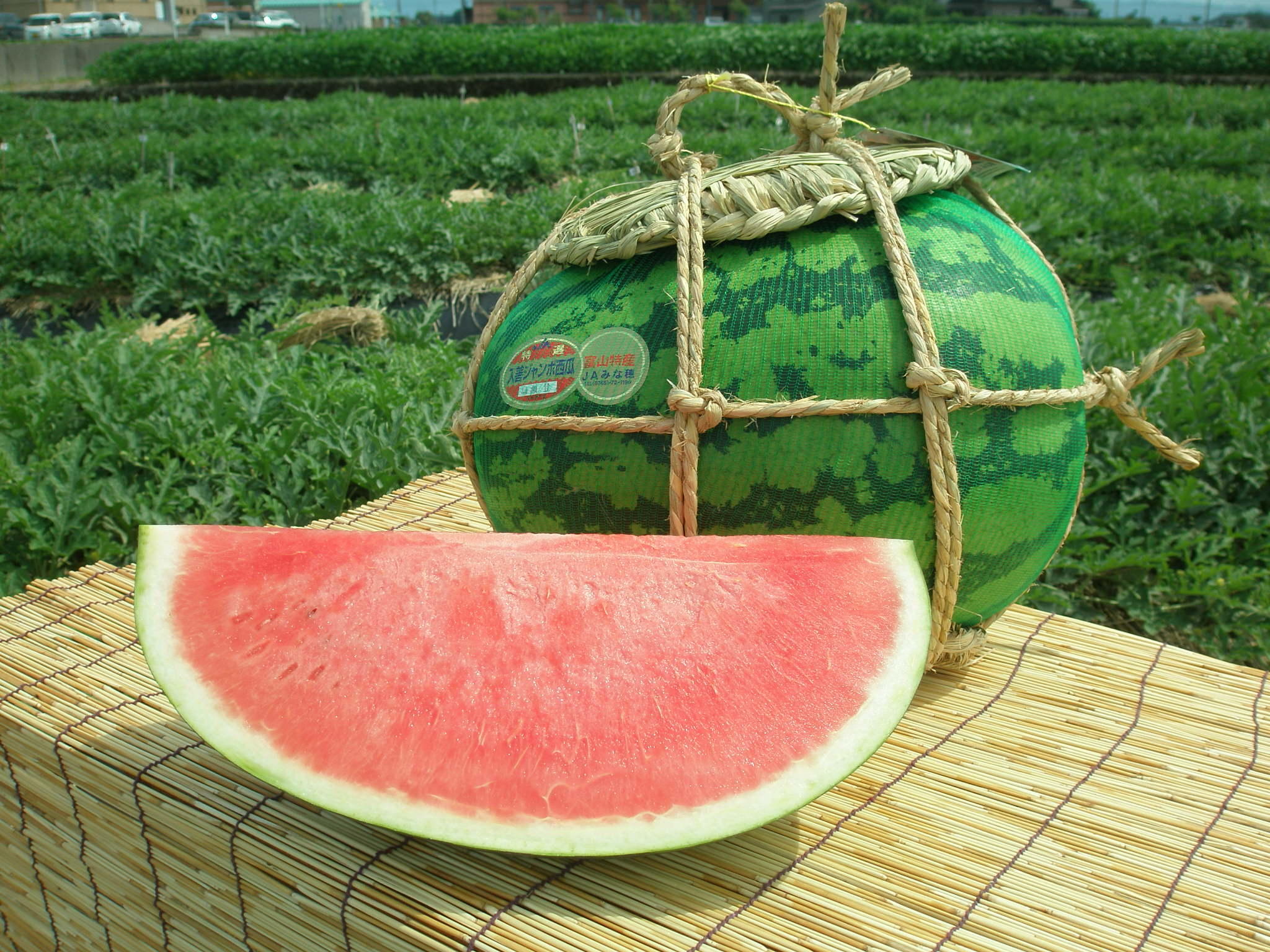NYUZEN JUMBO WATERMELON / Nyuzen Jumbo Suika
| Registration Number | 53 |
|---|---|
| Name of the GI | NYUZEN JUMBO WATERMELON,Nyūzen Jumbo Watermelon,Nyuzen Jumbo Suika,Nyūzen Jumbo Suika |
| Class | Vegetables/ Cereal grains/Pulses |
| Date of Protection | 2017/12/15 |
| Producing Area |
Toyama Prefecture
Nyūzen Town, Shimoniikawa County |
| Applicant - Name and Address | Minaho Agricultural Cooperative, 3489-1 Nyūzen Town, Shimoniikawa County, Toyama Prefecture |
"Nyuzen Jumbo Watermelon" are large watermelons cultivated at Nyuzen Town in the northeastern part of Toyama Prefecture. They are characterized by their unique, oblong shape, which resembles a rugby ball, and their deep-colored and distinctively striped skins.
Compared to ordinary Japanese large watermelons that weigh 7 to 9 kg on average, "Nyuzen Jumbo Watermelon" weigh 17 to 19 kg on average. Although they are large, they are also sweet, and when eaten, their gentle sweetness expands in one's mouth.
On account of their characteristic shape, size and flavor, "Nyuzen Jumbo Watermelon" are widely recognized by market traders and consumers as a summer feature and a fine local specialty product from Nyuzen Town in Toyama Prefecture. They are used widely at local festivals and events and are also given as precious ochugen gifts during summertime (1).
The variety of watermelon used for cultivation is the "Nyuzen Jumbo". Other varieties with equivalent characteristics as "Nyuzen Jumbo" also may be used.
In order for the watermelons to hypertrophy, they are planted out at intervals of over 60 cm. So as to concentrate nutrients in the watermelons that will be harvested, fruit thinning is conducted, leaving no more than two per plant. In addition, sunshades made of rice straw are used to prevent sunburn damage.
As well, to prevent repeated-cultivation damage, fields used once for cultivation are not subsequently used for at least 6 years.
Watermelons produced in this way are shipped to market when they reach a post-harvest weight of over 9 kg.
Nyuzen Town is located in northeastern part of Toyama Prefecture, which is surrounded by the Hida Mountains (2). The area is situated in a vast alluvial fan shaped by the Kurobe River (3). The area's soil type is sandy and shallow tillage soil. It has low water-retention capacity, making it possible to cultivate for a long period watermelons which are vulnerable to high humidity and to grow them big and heavy. Another factor of the popularization of watermelon cultivation in the area is the ease with which wet-paddy fields, occupying most of the town's farmland, can be utilized as watermelon fields.
Cultivation of large-sized watermelons has taken place in this area since around 1897. Cultivation techniques accumulated for over a century has given rise to cultivation and soil-management methods indispensable for improving the soil, controlling pests, and enlarging the fruits. In such a manner, a center of jumbo watermelon production was formed.
The cultivation of large watermelons, which started in the Meiji period, came to be conducted over 96ha in the Taisho period (1912-1926), when the watermelons were also exported abroad. However, in the years that followed, war and changing consumer tastes led to a reduction in the cultivation area. Therefore, in order to share cultivation techniques and improve quality, the "Nyuzen Town Kurobe Watermelon Production Cooperative" was established in 1971. Thereafter, in 1982, its name was changed to the "Nyuzen Town Jumbo Watermelon Production Cooperative" to reflect its aims of total quality control and promoting the town's local specialty product.
Around 1983, locally produced watermelon started being shipped to market under the brand "Nyuzen Jumbo Watermelon". In 2016, 4.1 hectares were being cultivated; the yield was 7,846 jumbo watermelons.
- Ochugen: In Japan, people customarily give gifts twice a year to "express appreciation" to people who have looked after them. Mid-summer gifts are called "ochugen", while year-end gifts are called "o-seibo". In former times, Nyuzen Jumbo Watermelon were placed in a type of straw bag used to store rice, "komedawara", to make them easier to carry. Even today, sometimes one finds watermelons packaged in a distinctive container made from woven rice-straw.
- Hida Mountains: A mountain range extending across Toyama, Niigata, Gifu, and Nagano Prefectures. The major part of the range is designated as the "Chubu-Sangaku National Park".
Kurobe River: A river that flows through eastern part of Toyama Prefecture. From its headwaters in the steep Hida Mountains, it flows 85 km to the Sea of Japan. Japan's tallest dam, the Kurobe Dam, is a famous tourist attraction in the river's watershed. - Meiji Period (1868-1912) and Taishō Period (1912-1926): The Meiji Period of Japanese history followed the overthrow of the Tokugawa shogunate. It was an era of modernization and Westernization. The Taishō Period witnessed further modern industrial and technological development.


